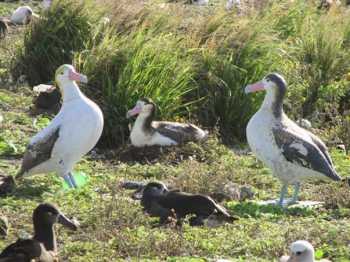A real American chick! The Midway Short-tailed Albatrosses hatch their egg
An important- and hopeful- milestone in the conservation of the threatened Short-tailed Albatross Phoebastria albatrus was recorded four days ago on 14 January at Midway Atoll National Wildlife Refuge, part of the Papahânaumokuâkea Marine National Monument in the North-west Hawaiian island chain. A Short-tailed Albatross chick hatched out on Eastern Island, one of three small flat coral islands that make up Midway Atoll. This event marks the first confirmed hatching of a Short-tailed Albatross egg outside Japan in recorded history. "We are all as excited as new parents," said Daniel Clark, acting Refuge Manager. "The chick hatched in the middle of a major storm but the parent is doing an excellent job of protecting it so we are guardedly optimistic about its chances for survival."

Establishing a new breeding colony is one of several important steps needed to continue the rare bird's recovery because volcanic activity regularly threatens the main breeding site on Japan's Torishima Island. The species' recovery also depends on reducing the threats of contaminants, especially oil contamination at sea and plastic ingestion; reducing bycatch from longline fisheries; and addressing invasive species and other competitive species at breeding colonies.
The Short-tailed Albatross pair was first seen together at Midway during the breeding season four years ago (2007/08) when they were observed spending only a little time together. During the second season (2008/09), their time together increased. By the third season (2009/10), they arrived at Eastern Island together and built a nest. This breeding season on 16 November 2010 an adult Short-tailed Albatross was observed incubating a freshly laid egg for the first time. The pair has been under remote camera observation since.
By the 20th Century, only two Short-tailed Albatross colonies remained on remote Japanese islands - Torishima Island in the Philippine Sea and Minami-kojima Island near Taiwan in the East China Sea. In 1939, the Short-tailed Albatross' main breeding grounds on Torishima were buried under lava from a volcanic eruption and population numbers plummeted to 10 breeding pairs. Since then, conservation efforts have helped increase the population to approximately 2400 birds, which forage widely across the North Pacific and can be seen in the Gulf of Alaska, along the Aleutian Islands and in the Bering Sea.
Refuge staff and volunteers will continue to monitor the Midway nest daily with the use of a remote video camera.
The above information has been taken and adapted from a US Fish & Wildlife Service press release - with thanks.
Go to http://www.flickr.com/photos/usfwspacific/sets/72157625522391142/ for great pictures of the proud parents and their chick.
Click here to access earlier ACAP stories on this exciting development. See also http://www.acap.aq/latest-news/the-short-tailed-albatross-nest-fails-on-kure-atoll-hawaii.
With thanks to Lindsay Young, ACAP North American News Correspondent, for information.
John Cooper, ACAP Information Officer, 18 January 2011

 English
English  Français
Français  Español
Español